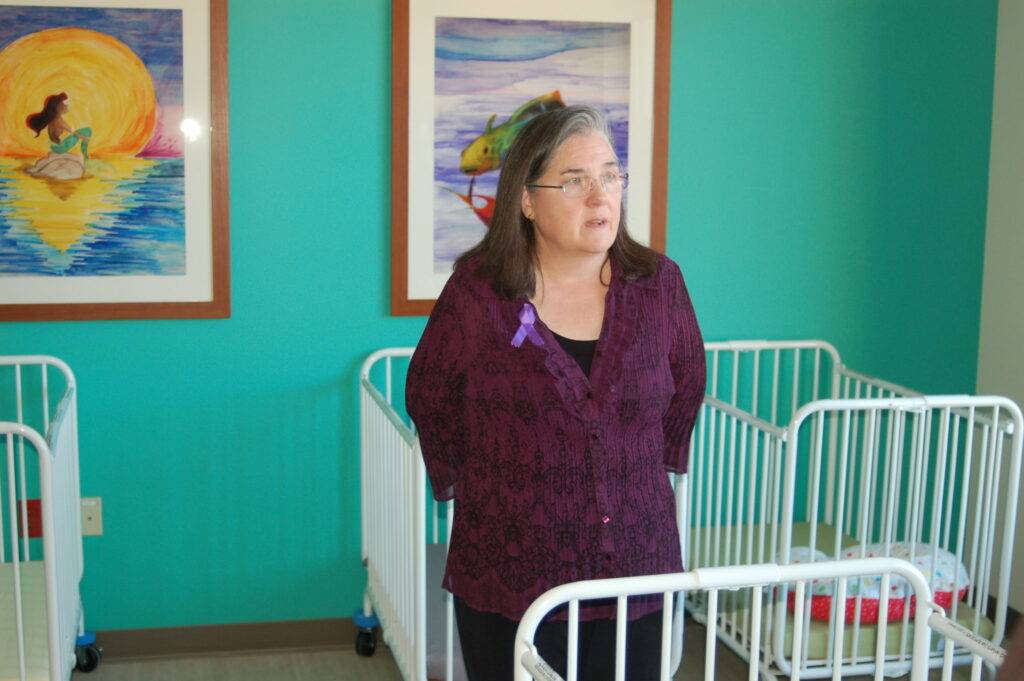Women of Color Face Elevated Rates of Domestic Abuse, Homicide
Of 21 women killed in 2022 under abusive circumstances, 17 were Black, Milwaukee Police Department data shows.

Carmen Pitre, president and CEO of Sojourner Family Peace Center, gives a tour of its facilities, which includes shelter and direct services for victims of violence and abuse. (NNS file photo by Andrea Waxman)
Milwaukee is a more dangerous place than it was four years ago.
Especially for women of color.
“I think pretty much any indicator of violence you look at has gone up,” Carmen Pitre, CEO and president of Sojourner Family Peace Center, said. Sojourner is a nonprofit that supports and advocates for victims of abuse and violence.
After a period of steady decline of homicides and shootings in Milwaukee County, the number of victims has jumped each year since 2019, according to data from the Milwaukee Homicide Review Commission.
In 2019, there were 542 such victims. Three years later, that number jumped to 1,083, an increase of roughly 100%.
Women of color are far more likely to be killed by an intimate partner or men they know.
According to 2021 data from the U.S. Bureau of Justice Statistics, 34% of female victims of homicide and “nonnegligent manslaughter” were killed by an intimate partner, compared to 6% for men.
Black women most likely to be killed
In Milwaukee, the situation is further layered by race and ethnicity.
Black women are more likely to be killed by someone they know than their racial/ethnic counterparts, according to data requested by NNS from the Milwaukee Police Department.
Of the 21 women who were killed in 2022 under abusive circumstances, 17 of them were Black; three were Latina and one was Asian, according to police data.
This public data is consistent with data compiled by Sojourner, which indicates that the majority of serious abuse takes place primarily in Milwaukee Police Department Districts 3, 4 and 7 on the North Side.
Less obvious forms of abuse
Violence is perhaps the most visible form of abuse and is more easily tracked. Yet abuse also can be verbal, emotional, financial and spiritual.
For example, in the Hispanic/Latina community, a male abuser may threaten a woman with immigration issues, along with the threat of deportation and the possibility of being separated from her children, said Roderick Richardson, UMOS spokesperson.
UMOS is a nonprofit that helps underserved populations.
Spotting abuse, therefore, is not as straightforward as looking for bruises or broken limbs.
One clear sign is if someone is consistently isolating themselves, said Danielle Romain Dagenhardt, assistant professor in criminal justice and criminology at the University of Wisconsin-Milwaukee.
“Part of that can be real, legitimate things going on in their life, but if it’s a very sharp change without some understandable reasons on why they’re pulling back so much from family and friends, that can be a warning sign that the person they’re in a relationship with might be really controlling,” Romain Dagenhardt said.
Red flags
A common red flag, said Romain Dagenhardt, is “if a partner of a person insults them in front of other people, especially if it’s insulting really minor things that they’re doing, making it seem like it’s a big deal – insulting the way they look, the way they act, who they are as a person.”
“It shows that they’re comfortable with … demeaning that person not only in private but in public spaces,” she added.
Cindy Milner, who is a licensed clinician of social work and has worked in Milwaukee with victims of violence and abuse for several years, emphasized how victims of abuse can carry a sense of helplessness or powerlessness around with them.
“Victims of abuse will often be more submissive on the job,” she said. “They may have difficulty standing up for themselves and being assertive. They may not be able to trust their judgment, so they rely on others to, kind of, guide them through that.”
Kids put in tough situations
Another reason advocates say it is valuable to focus on abuse and violence against women is the ripple effects these have on children.
Women are far more likely to be the caretakers in a family, so an attack on them leaves children in far more unpredictable, dangerous situations.
In Pitre’s experience, children move approximately three to four times in the first six months following a violent incident, she said.
“These kids live in fear,” Milner said. “They may develop post-traumatic stress disorder. They’re very anxious. They’re very depressed. There’s a lot of cortisol in their system. And it’s very likely they may experience some physical problems, fibromyalgia and chronic fatigue…so there are a lot of dynamics.”
Where to get help
The City of Milwaukee maintains a webpage with links to resources and information.
There also are several different organizations throughout the city that serve various populations, and various needs.
Devin Blake is the criminal justice reporter for the Milwaukee Neighborhood News Service. His position is funded by the Public Welfare Foundation, which plays no role in editorial decisions in the NNS newsroom.
Milwaukee more dangerous for women of color, new data shows was originally published by the Milwaukee Neighborhood News Service.





















